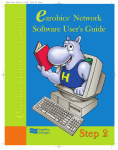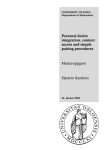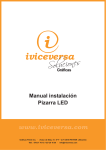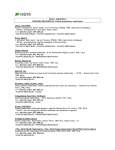Download Mission Control!
Transcript
Mission Control! INF2260 – Human-Computer Interaction Bachelor Group: Doreen Nalliasca Navidi, Qiang Gu and Jørn Emil Stensby 1 Contents Introduction ............................................................................................................................................. 3 Background ......................................................................................................................................... 3 Project Group Introduction .............................................................................................................. 3 Project Assignment.......................................................................................................................... 3 Project walkthrough ........................................................................................................................ 3 Client Introduction .......................................................................................................................... 3 Product Introduction ............................................................................................................................ 4 Overview ......................................................................................................................................... 4 Installation and basic setup .............................................................................................................. 5 Emotiv Control Panel ...................................................................................................................... 5 Expressiv Suite ................................................................................................................................ 6 Cognitiv suite .................................................................................................................................. 7 Project Schedule .................................................................................................................................. 8 Research methods .................................................................................................................................... 8 Descriptive exploration ....................................................................................................................... 8 Experimental Research ...................................................................................................................... 10 Gadget Noise Test & Data Collection Phase ................................................................................. 11 Ethnographic Observation ............................................................................................................. 14 Usability Testing: Expressive Suite (facial expressions) and Cognitive Suite .............................. 14 Emotiv integration to Petrel........................................................................................................... 17 Summary ............................................................................................................................................... 20 Appendices ............................................................................................................................................ 22 Appendix A: Informed Consent Form............................................................................................... 22 Consent Form for Testing.............................................................................................................. 22 Appendix B: Usability Testing: Expressiv Suite (facial expressions) ............................................... 23 Appendix C: Usability Testing: Cognitiv Suite (conscious thoughts) .............................................. 26 Appendix D: Raw Data for Cognitiv and Expressiv Suits ................................................................ 28 2 Introduction Background Project Group Introduction Mission Control! Project group has three members: Doreen, Qiang and Jørn Emil. The team members are from different cultural background, Philippine, China and Norway. We are bachelor students from University of Oslo, studying Informatics: Design, Use and Interaction. Since we all have the basic year here at UiO for interaction design, we have some knowledge on human-computer interaction design. As the team members are from different background, it will give us different insights into this project. Project Assignment “This project involves the analysis of Emotiv information as to improve human-computer interaction in two areas: one on replacing or complementing mouse interaction (with emphasis on its use on Petrel); and two, using Emotiv information to quantify user satisfaction. The project will start with the analysis and implementation of basic 3D scene interaction and later will evolve into more elaborate workflows and interactions.” (From the project description) Project walkthrough In the beginning of this project we had brainstorming on how could we tackle this project and we gather questions that will pave way for our progress. The following are the questions regarding this project 1. 2. 3. 4. 5. What is Emotiv and how does it work? Is it possible for this device to replace the mouse? What is Petrel software? What features of Emotiv can we use to integrate with Petrel How can we integrate Emotiv with Petrel? After we explore the first question more questions pop up that lead us to the progression of this project. Client Introduction Schlumberger is the leading oilfield services provider in the world. The company provides solutions for oil and gas companies and has offices around the world. The company aims to develop products, services and solutions that optimize customer performances. In Norway, Schlumberger has research centers both in Oslo and Stavanger. Our project is carried out in Oslo office. 3 Petrel is a Schlumberger owned Windows PC software application. It is used to aggregate oil reservoir data from multiple sources. Users can use this application to interpret seismic data, perform well correlation, build reservoir models suitable for simulation, submit and visualize simulation results, calculate volumes, produce maps and design development strategies to maximize reservoir exploitation. Schlumberger aims to build this software into a single application portal which will reduce the need of multitude of highly specialized tools, and can control the lifecycle of the petroleum data. Our project is based on two products: Emotiv EPOC and Petrel. The first one is a combination of software and hardware product, while the second one is the software application. Emotiv EPOC is a device which can detect and measure brain waves. It is a high-fidelity Brain Computer Interface (BCI) which reads and interpreters both conscious and unconscious thoughts from the users. After meeting with people from Schlumberger, we have some information listed, and those listed information are what people in Schlumberger expect us to do with Emotiv and Petrel. 1. Is it feasible to use Emotiv in practical areas in our daily life? 2. How far can we integrate Emotiv device with Petrel software? 3. Is it possible to use Emotiv to control some programs? We need to test the performance of the Emotiv with quantifiable results. According to those listed requests and the available testing products, our research project is based on high-fidelity prototype, or we can say that it is based on finished commercial product. Product Introduction Overview Emotiv EPOC is a device which can detect and measure brain waves using 16 sensor units. (See picture 1). Each “arm” has a sensor at the end which is a sensor unit. It is, as previously stated, a high-fidelity Brain Computer Interface (BCI) which reads and interpreters both conscious and unconscious thoughts from the users. PICTURE 1 - Headset placement Petrel is a Schlumberger owned Windows PC software application. It is used to aggregate oil reservoir data from multiple sources. Users can use this application to interpret seismic data, perform well correlation, build reservoir models suitable for simulation, submit and visualize 4 simulation results, calculate volumes, produce maps and design development strategies to maximize reservoir exploitation. Schlumberger aims to build this software into a single application portal which will reduce the need of multitude of highly specialized tools, and can control the life-cycle of the petroleum data. Installation and basic setup The installation of the Emotiv software was pretty straightforward and we did not encounter any problems at all. We installed it only on Windows. After reading the user manual we started by moistening the sensor knobs and charging the batteries which is also easy and straightforward. Picture 2 has all the items in the EPOC Headset Kit. PICTURE 2 - Overview of equipment From the top left: Neuroheadset, USB Transceiver, CD Installation disk (Windows only), Hydration Sensor Pack with 16 sensor Units, Saline solution and Battery Charger. The USB transceiver will connect the headset with the computer. The Hydration Sensor pack is where the sensors will be stores when they are not connected to the headset. The saline solution is used to moistening the felt in front of each sensor and it also disinfect. As to Petrel, it is professional software for petroleum industry. The setup and use of the software will take quite long time due to the special requirements for this professional software. People from SLB help us to go install the software on SLB workstation, and guide us through some basic functions for this software. Due to the special requirements for this software, we cannot install Petrel on our own laptop and try it at home or in the university. It means that we will have limited time on learning or use this software, so we will limit our research target to some basic functions under this situation. Emotiv Control Panel The Emotiv Control Panel is one of the user-interfaces and the one that controls and connects with both EmoComposer and EmoEngine. (We`ll come back to this). The first one will see is the Headset setup (picture 4). This will provide the user with a headset setup guide which basically just is guidance regarding how to fit the neuroheadset on the head. As you can see on the picture below are all the sensors green which indicates very good signal. 5 PICTURE 3 - Emotiv Status Panel Furthermore it displays Expressiv suite, Affectiv suite and Cognitiv suite which we will all explain respectively, but first we`ll go through the top part of the window. PICTURE 4 - Top of Control Panel This is the top part of the Control Panel (called EmoEngine Status Pane) which will provide real-time feedback regarding the system status, wireless signal, battery power and so on. This is also where you can manage user profiles. The “head” displayed at the far right indicates how good the signal is from each of the sensors. Black: No signal, Red: Very poor signal, Orange: Poor signal, Yellow: Fair signal and Green: Good signal. This top will, as you can see on the next few pictures, be displayed at all times. Expressiv Suite The Expressiv suite has to the left an avatar mimicking the facial expressions of the user and in the middle a series of graphs indication the expression detection. To the right there is sensitivity adjustment for the facial detection. 6 PICTURE 5 - Expressiv Suite Affectiv Suite This will the area focused by the other Emotiv group. Cognitiv suite The Cognitive suit uses a 3D representation of a cube to demonstrate the Cognitiv detection. There is three different tabs here; Action, Training and Advanced (See picture 6, below). PICTURE 6 - Cognitiv Suite The action tab is where the current state of the actions and the detection status. Here you are able to add or remove actions (one action is e.g. “push”). You can also see how skill-full you are in doing different actions and your overall skill rating. The training tab is where you train each action. The EmoEngine analyzes your brainwaves and develops an own “person”. Hence the ability to have different user profiles. Two different persons can have one user profile each with their own training and the software will remember it so one does not need to train the same action the next time one will use the software. The advance tab is for customizing the behavior of the Cognitive detection. The user manual does not recommend normal user to adjust these settings 7 Project Schedule After the discussion with the customers, we proposed a tentative timeline for our project. In order to track the project process, we created a Gantt chart (Sommerville, Ian, 2010) to list out our expected target for each period. The advantage for the adoption of the Gantt chart is that it can illustrate the start and finish dates of the terminal elements and summary elements of a project. Those elements comprise the work breakdown structure of the project. The Gantt chart also shows clear relationships between activities. We can track current schedule status using percent-complete shadings. PICTURE 7 – Project plan Research methods We have conducted the following methods: Informal interview, descriptive exploration, experimental research and usability testing. In the following we will explain how we contacted and implemented each of the methods. Descriptive exploration First impression In our initial use of the Emotiv device we encounter a big problem at once, which is how to make it properly work. The manual stated that all sensors must physically touch the scalp or skin and because most of us have thick and long hair, this gave us a challenge with mounting the headset. In the span of approximately two hours the seven of us alternately tried to make the Emotiv work. Unfortunately none of us manage to make Emotive EPOC work. This we found weird because the headset Hakeem had (which is the Emotiv Researcher headset) we got working on two of us. After this experience we all wondered if the room (Sonen) we were staying at was one factor that could influence the Emotiv. We thought that all the gadgets inside Sonen interfered with the signal detection of Emotiv. As to Petrel, it is professional software for petroleum industry. The setup and use of the software will take quite long time due to the special requirements for this professional software. People from SLB help us to go install the software on SLB workstation, and guide us through some basic functions for this software. Due to the special requirements for this 8 software, we cannot install Petrel on our own laptop and try it at home or in the university. It means that we will have limited time on learning or use this software, so we will limit our research target to some basic functions under this situation. Emotiv training Since Emotiv is just almost decade young technology we decided to find out all about Emotiv. We would like to find answers for questions like “Does it really work?”, “How does it work?”, “Do Emotiv rely on the software or does it need people skill to be able to make it work?” and “How long does it take a user to train and start using it?”. Each member of control group tried and explored the Emotiv device to find out how effective or viable Emotiv is. Each member trained and used the different facial and cognitive actions on Emotiv. The following are the summary of our exploration: Good signal is the key for Emotiv to get the best result. Signals affect the use of different actions. When you’re using the Cognitiv or Expressiv suite, it is harder to switch from one action to other actions. When you have low signals the actions sometimes don’t get registered due to poor detection. It is also harder for a user to train a particular action. Among the three classes, Expressiv, Affectiv and Cognitiv, only Expressiv and Cognitiv contain actions that can be trained. Before you can use the Emotiv fully you are required to train neutral state and a few actions. Training neutral actions is necessary so that a particular brain signal pertaining to a particular action can be compared to the neutral signals. Training neutral a user needs to be in a relax state especially with expressive actions. The user should avoid twitching while training the neutral state or Expressiv suite. The Twitching can be detected as neutral state. For instance if you manage to smirk while training when you do smirk it will be registered as neutral and will not be registered as smirk. Training the expressive suite (facial expressions) The Expressiv suite have a universal roster of actions for any user to use, but expressive suite has a training functions for some facial actions, such as mouth movements (smirk left, smirk right, smile, laugh and clench) and eyebrow movement (raise eyebrow and furrow). The eye movements do not need training. The Emotiv detects the eye movements at once. Using the facial expressions on any application doesn’t require training but it’s up to the user to train all actions if he wants to customize the actions for him/her. For example if a person have problem doing the clench facial actions he can customized this action by pouting his lips or biting his/her lower lip. Sometimes some facial expressions have strong detection signals than other facial expressions; this makes it harder for a user to control the switching of actions. This particular problem can be solved by decreasing the detection on the Sensitivity tab. If an action has a high detection there is a high probability that the manipulation of object will be dominated by this action. For example on Google earth you want to zoom in using raise eyebrow but instead it keeps on going to the left which is assigned to the facial action “smile”. It is possible whenever you move your eyebrow, your mouth move slightly at the same time. Although it’s just a small movement, Emotiv can detect this movement. To avoid this kind of problem, we can decrease 9 the signal detection of action “smile” under sensitive panel, which will lessen the random movement that action “smile” caused. This also applies to actions with low detection. Sometimes actions don’t get registered at all. No matter how much you raise your eyebrows, the application like Google earth doesn’t react at all. This is due to low signal detection of facial expression “raise eyebrow”. The solution is to increase the detection on the Sensitivity tab. Training the Cognitiv suite (conscious thoughts) There are two ways to train Cognitiv suite. The first method is to train each action individually. You can train each action until it reach up to 100%. Depending on different factors, sometimes reaching 100% on each action takes only 8 minutes, while other time it will take quite a long time, even only 80% control on the action. The problem with this method of training is switching or controlling each action. Controlling skill requires long training time. The second method is to train all the actions at the same time. The Emotiv allows user to train maximum of four actions at a time. Training four actions at one time and trying to reach 100 % for all actions is harder, but the positive thing is that you can train your action controlling skill at the same time. This method takes a long time to achieve expected result, but can give more positive feedback. From picture below, we can see that tester has successfully got 100% control on the actions. PICTURE 8 – All training 100 %. Experimental Research We conduct experimental research because we want to identify if the electronic gadget is responsible for the bad signal. Due to the time constraints and the unavailability of the users, we decide to adopt Within-Group mode. Ideally, it will be better to use two separate groups, one in the Gadget Noise Place, and another group as controlled group in the Noise Free Place. 10 Gadget Noise Test & Data Collection Phase Before the formal tests start, we need to have data regarding those elements which could affect our tests results, such as the noise on the signal, different environment, the shape of the head, as well as the gender influences. We have recruited 10 participants for our Gadget Noise Test. Each participant will test Emotiv product in different environment: one in Noise Place, another in Noise-free place. It means that we will have 20 sets of data collected from those 10 participants. The ideal participants should be those geologists from petroleum industry, but we were not able to get that many. Instead we used informatics students to help us to do the tests. Below are some explanations on Noise Place and Noise-free Place: 1. Noise Place: We intentionally put many electronic products around us, and we selected Sonen as the room location because it has many computers as well as digital products. The purpose is to establish an environment with as many digital products as possible. 2. Noise-free Place: We will choose a place without or with as few as possible electronic products so as to reduce the influences on the signals. We will use the same group of people for both Noise Place test and non-Noise Place in order to eliminate the influences from individual differences. Hypothesis for Tests: H0: There is no difference between Noise Place and Noise Free Place on the signal strength. H1: There is a difference between Noise Place and Noise Free Place on the signal strength. We will determine the signal strength according to the number of the different lights on the products panel as listed below: PICTURE 9 – Sample picture of signal strength. As the picture shown above, we need to test the signal strength according to the different lights appearing on the panel. The signal strength can be classified into several levels from Green, Yellow, Orange, Red and Black (no signal at all). 11 In order to get qualified data for the tests, we will check signal strength after the participants have had the helmet on for around 5 minutes. The reason the tests are quite short is to avoid fatigue among our participants. Not to mention that the students we use as users are often busy and can only give us a few minutes of their time. In order to clearly show differences between Noise Place and Noise-free Place, we created the excel data collection table. Below are two examples for two different participants: PICTURE 10 – No Noise Place PICTURE 11 – Noise Place As we can see that we have also made comments regarding the gender, hair and sensor. In order not to make the tests data analysis quite complicated, here we will not take those extra elements into considerations as the tests are mainly focusing on the signal influences from digital products. In order to analyze the data, we have assigned below numbers to those different color lights: Green: 4 Yellow: 3 Orange: 2 Red: 1 Black: -1 The total of those numbers can be used as the quality measurement for signal strength. The bigger the total number is, the better the quality is. We multiply the number of greens to the corresponding points. As we have highlighted in the “No Noise Place” in PICTURE 4 the user get 14 green (56 points), 1 yellow (3 points), and 1 orange (2 points). This equals to the total points of 61. We have collected the data from 10 participants with below summary table provided: 12 PICTURE 12 – Noise test summary table. Here, we start to calculate the data like below: No Noise Test Data: Total Points Noise Test Data: Total Points = 561; Average Points = 56.1 = 519; Average Points = 51.9 If all the participants achieve all green lights, then the maximum average points should be 64. Based on this information, we can get below percentage number for each group: No Noise Percentage: (56,1*100) / 64 = 87.6% Noise Percentage: (51,9*100) / 64 = 81.1% When we compare those two sets data, we can see that participants can get better signal in the no noise place. The test was carried out at the beginning of our project. When we conducted this test, we were not aware that the moisture level for the signal detector on Emotiv has significant influences on the test. At first, we had thought that it was good enough to just put several drops of Saline solution on the signal detector, but we found later if we add enough drops on the detector, we can get all green lights for the signal detection. The sample for the participants is small, and the environment is not strictly noise free as we carry out the test in the university building. Ideally, the sample size should be large, and the test room should be completely noise-free laboratory compared with noise place. 13 Ethnographic Observation Our target users are experts who have many years’ experiences in IT industry. They have very strong knowledge on the software development and IT technology. The products which we are to use also are very professional ones. The more observation we have the better insight we can get. The challenge is how to get in contact with many geologists and be able to observe them. We were lucky and came in contact with one professional geologist who works for a petroleum consultant company, and also needs to use Petrel every day. This made us able to get a first-hand observation on a real working situation regarding petroleum-related tasks. We observed the geologist interaction with mouse, keyboard actions, and classified them into 6 types: Click, Move up, Move Down, Zoom In, Zoom Out, and Keyboard Input. We observed the geologist in four different sessions which lasted about 20 minutes each. This is of course a small sample size, but as we already stated we were not able to observe more than one. All actions have been recorded and calculated according to percentage so as to find out which action is most likely used during the whole process. PICTURE 13 – Seismic Interpretation The data shown above clearly demonstrates to us that most of geologists’ works are connected with the mouse actions. We had an interview with geologist, and got those key information listed below: Average Project Time for Geologist: 3 to 6 months Average mouse control actions: At least 70% for the whole project as far as seismic interpretation project is concerned. Based on that information, we could draw a tentative conclusion if we could help them to reduce the workload by using Emotiv, it will be great relief for petroleum industry. Usability Testing: Expressive Suite (facial expressions) and Cognitive Suite We use usability testing to test Expressive Suite and Cognitive Suite on Emotive to find out if those suits are feasible enough to integrate into software. Because this is high fidelity commercialized product, we decide to adopt summative test. We chose to use Google earth because the interaction use on Google earth and Petrel software’s model part is almost the same. According to the project requirements we’re supposed to have atleast10 participants for the test. We manage to gather a total of 10 participants that were willing to use and test the Emotiv. 14 We tried to get both gender and different age bracket. We know that to represent the general population we need to have representation from different groups such as disable people. We know that using people with physical disabilities requires contacting the appropriate institution for participants. Due to limitation and time constraints, including unavailability of the participants, we recruited the students as convenience sampling for the project. In this test we would like to find out: ● How many facial expressions/cognitive actions can we use to integrate to an application (Google Earth)? ● How many actions can we control? ● If facial expression is more accurate and viable than cognitive and vice versa. After learning that Emotiv has three classes of detection, which we use to map up different actions to different keystrokes. We then decided to test facial expressions on Google Earth. Users were asked to use the Emotiv with facial expressions to control the movements of Google Earth. We mapped each action to keys corresponding Google Earth’s interaction like move up and move down. We decided to do three usability testing based on facial expression, and we conducted the test according to the following scenarios. ● 2 expressive actions - up and down ● 4 expressive actions – up, down , left and right ● 6 expressive actions – up, down, left , right, zoom in and zoom out We first conducted a pilot test on each usability test to find out if the test is harmful or hard for the participants and whether it is time consuming. We also tried to minimize the errors and problems we might encounter during the test. The picture below shows one of the pilot testing we conducted. PICTURE 14 - Description Before the test implementation we asked each participant to sign a consent form that states that they understand what the test was all about and that they were willing to participate. The consent form contained the groups contact details. The first usability test applies to the first scenario which is two facial expressions. We asked participants to use two facial expressions to manipulate Google earth. The participants were then asked to follow the instruction of the test facilitator. 15 Following the task on our usability test design the facilitator asked the participants to train and performed the actions three times with pauses in between. The pauses showed us if the actions were triggered and intended by the participants and not just random movements. If the participants managed to do 0 to 1 action this was considered unsuccessful task and 2 to 3 actions are considered successful task. The first test didn’t take a long time to implement. We then politely asked the participants if they will be willing to do second test which was the next scenario 4 facial expressions. The same procedure was followed for the second test. After the second test, since it is hard to find willing participants, we once again politely asked the same participants to do the last test on facial expressions. We are thankful that all participants who participated on the first two tests graciously allowed us to do last test. This last test was conducted the same manner as the first two test. The only difference was the number of facial expressions with corresponding actions the participants use and do. Below is the data collection table (V: Success; X: Fail): PICTURE 15 – Expressive data result During the test we encouraged the participants to say what they think and feel while doing the experiments. Participant’s comments during expressive suite testing ● It is easy to control two expressive action ● For some participants they feel discomfort after for long usage of the device and for some they feel no discomfort at all. ● During 4 expressive actions one user commented that it was harder to control. One participant in particular said it was hard for her to make the Google earth stay sill for a few seconds. It randomly moves. ● They get distracted doing the expressive actions especially when someone is staring at them. We asked one particular participant if we could take a video of him while testing. It made him really unable to do simple facial actions. ● They need to concentrate and try keeping their faces still which they find hard. ● One participant said it is hard for her to make the Google earth stay sill for a few seconds. It randomly moves. ● When some of the participants use actions such as “Look Left” and “Look Right”, they unconsciously raised their eyebrows at the same time which Emotiv register it as a normal detection that causes unnecessary non-intended random actions. ● At one point one of the participants asked us whether Emotiv emits radiation. We don’t have the proper facilities to test it. 16 We followed the same procedure during testing for Cognitiv suite. We manage to test some participants using 4 Cognitiv actions. The detailed usability testing plan can be found on the appendices (Appendix E and Appendix F) The data collection for Cognitiv Suite is listed below: PICTURE 16 – Cognitiv data result As some participants just gave up in the middle of the tests as the tests took quite long time for them, the data collected here were compromising result. By comparing the success rates between Expressiv Suite (PICTURE 15) and Cognitive Suite (PICTURE 16), we can say that Expressive Suite have more potential reliability as Expressiv Suite has better results. The Expressiv Suite is more reliable. Based on the tests carried out above, we can draw a conclusion that it is much easier to use Expressiv suit to carry out actions than Cognitiv suit. This is why we will adopt Expressiv suit for our software development test in the next step. Emotiv integration to Petrel The usability test shows that Expressiv suite (facial expression) gives more positive result than Cognitiv suite (conscious thoughts). Schlumberger then asked us to make a simple program using the Emotiv Soft Development Kit. The purpose for this program is to integrate it with Schlumberger’s Petrel software, so we can communicate with Petrel by using the headset. The program was mainly to check if it was able to communicate with the EmoEngine (which then communicates with the headset) without the need of assistance from the EmoKey program. As Petrel is a commercialized product, it needs highly strict requirements from the developers to develop software plug-in for it. The software developed by us has been divided into two stages: 1. Initial Software Plug-in As we cannot use Petrel on our laptop due to the limitation, we have developed the software and tested on our own laptop to see whether it can realize some function as we expected. 2. Second Version Software Development After we have tested the software, we sent the source code to Schlumberger people; they modified the software so as to connect the software with Petrel. It turned out to be good version software. Here, we will list out the screenshot for the software: 17 PICTURE 17 - GyroUse The source code of this program can be found in the appendix. In order to test the effectiveness of the software with Petrel, we asked the testers to use facial expressions to control Petrel. The main actions are: Move Right, Move Left, Zoom In, Zoom Out, Up and Down. We carry out series tests for our software plug-in in order to perfect the software as well as for better control on Emotiv. Test one video on Petrel: PICTURE 18 – Sample from the video Link: https://docs.google.com/file/d/0B3bTM3mhLsftaWpIYVFoaFJTc00/edit From this video, we can see that after several minutes’ successful control on Petrel with the help of the developed software, the tester herself cannot easily control her facial expressions. The same results also can be found during the Facial Usability test process for the participants. Final test video both on Google Earth and Petrel: 18 PICTURE 19 - Google Earth Testing PICTURE 20 - Petrel Software Testing Video Links: https://docs.google.com/file/d/0B3bTM3mhLsftQWxBbUl2TnhqQjg/edit In this video, we asked the tester to find Oslo, Norway. As you can see from the video, the tester successfully carries out those operations according to our expectations. Due to the business restrictions, we are not able to use Petrel software outside Schlumberger office during the whole process. We take advantage to use Petrel software when we are in Schlumberger office. The Google Earth controlling was done through EmoKey; a subprogram of Emotiv Control Panel which allows users to assign different actions (both Expressiv and Cognitiv) to a specific keystrokes on the keyboard. The people from Schlumberger modified this program to integrate it to the model part of the Petrel software. The video from above was taken at one of the testing sessions we conducted during our stay at Schlumberger. During this test the tester show confusion when the facilitator asked her to do some actions. She executed actions opposite of what the facilitator was asking her to do. Fatigue could also be the reason for her lack of concentration. But overall result was a success despite the fact 19 that the software itself needs modification. We can say that this program is still work in progress. Summary Our project is about Emotiv EPOC as mentioned earlier it is a Brain computer device that allows user to control an object like computer or even wheelchair. We worked together with Schlumberger which is one of the leading service providers for the petroleum industries. Initially Emotiv EPOC is developed for gaming purposes. Emotiv developer wanted to give users a different gaming experience. But, does it really end there or can Emotiv have more possibilities? This curiosity leads to this project. In this project we tried to find out if Emotiv can actually replace mouse. Or maybe we can combine it with mouse and keyboard to do normal office or other computer related work. When a new technology arises, it will take some time for people to learn the new technology. Not all people are always open to the new technology, they may get skeptical about those new things, but if skeptics stop all developer or inventors from pursuing their ideas, we will not have the leisure of enjoying the new technologies we are using now. It is true that Emotiv is quite new and people may be skeptic about it. But looking forward 10 or 15 years from now, Emotiv might be fully developed, useful and beneficial for the general public. Specially for people with disabilities, or people who are paralyzed from neck down who still have the ability to use their brain, or for the working people like the geologist from Schlumberger who worked most of the time with computers using mouse and keyboard, who are vulnerable to wrist or armed injuries due to extensive use of mouse and keyboard. This will ease the pain if they have such injuries or prevent them from having the injuries. That injury prevention will lead to less people going through sick leave because of pain. It will benefit the company, employee and government. This project satisfies our curiosity of “what if we use Emotiv instead of a mouse.” This project is still a working progress that needs more modifications. Maybe when the new modified version of Emotiv EPOC, we can find greater use of this device. During the whole process, we have learned how to gather the data, how to leverage the resources from different places, and we also learn some experiences from the industry company regarding the project control. At the same time, the project is carried out among three students from different cultural background, so we have learned to cooperate with each other to have common understanding. The tests did not go smoothly as we had expected due to specific unforeseen situations during the whole process. We have to balance our time and resources to achieve the expected the target. “Creativity is not the finding of a thing, but Making something out of it after it is found.” –James Russel Lowell (1819 – 1891) 20 References Lazar, Feng og Hochheiser: Research Methods in HCI, 2010. Wiley. ISBN: 978-0-470-72337-1 Sommerville, Ian: Software Engineering, 9th ed, 2010. Pearson Education Limited. ISBN: 978-0-13705346-9 Web sites: http://www.emotiv.com/ 21 Appendices Appendix A: Informed Consent Form Consent Form for Testing I hereby give my consent for my participation in usability testing for Schlumberger - mission control project created to meet the requirements for INF2260 Interaction Design. I also understand: The people responsible for this project and testing are Doreen Nalliasca Navidi, Jørn Emil Stensby and Qiang Gu under the supervision of Alma Leora Culen. I understand that the testing will focus on the usability of Emotiv EPOC device. I understand that the testing will include: -A pre-testing demographic survey (5 minutes.) -Usability testing tasks (Max 10 minutes) During the usability testing I will be observed and the testing will be recorded with notes. I understand my information will be kept anonymous and that under no circumstances will I be identified by name or other characteristics when Doreen Navidi, Jørn Emil Stensby and Qiang Gu report the results of this study. I understand only Doreen Nalliasca Navidi, Jørn Emil Stensby and Qiang Gu will have access to the non-anonymous records and data collected with this study and that all data will be strictly confidential. I understand that I may discontinue this study at any time I choose without penalty. I understand that Doreen Nalliasca Navidi, Jørn Emil Stensby and Qiang Gu has agreed to answer any questions I may have about their research, the acquisition of data, or their procedures; and that I may contact Alma Leora Culen with any further questions or concerns. ☐ Yes, I'm willing to participate in this usability testing research. ☐ No, I do not feel comfortable participating in usability testing research. Name and Signature:______________________________________________________ Contact Information__________________________________________________________ ___________________________________________________________________________ ___________________________________________________________________________ For more Information on this study feel free to contact me 22 Doreen Nalliasca Navidi [email protected] Qiang Gu [email protected] Jørn Emil Stensby [email protected] Appendix B: Usability Testing: Expressiv Suite (facial expressions) 23 24 25 Appendix C: Usability Testing: Cognitiv Suite (conscious thoughts) 26 27 Appendix D: Raw Data for Cognitiv and Expressiv Suits 28




























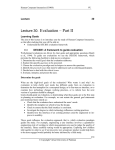

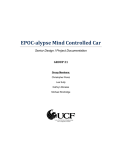
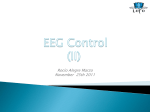
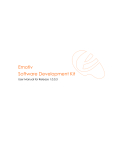
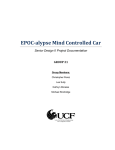

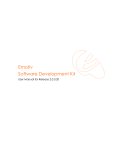
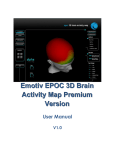
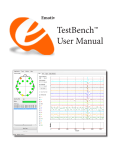



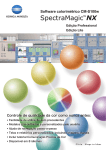
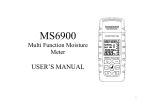
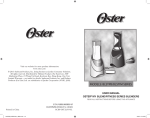
![SOLOSTORM USER GUIDE [VERSION 1.2]](http://vs1.manualzilla.com/store/data/005689152_1-d7af094c3c32ee16b7966cd6221b7607-150x150.png)
